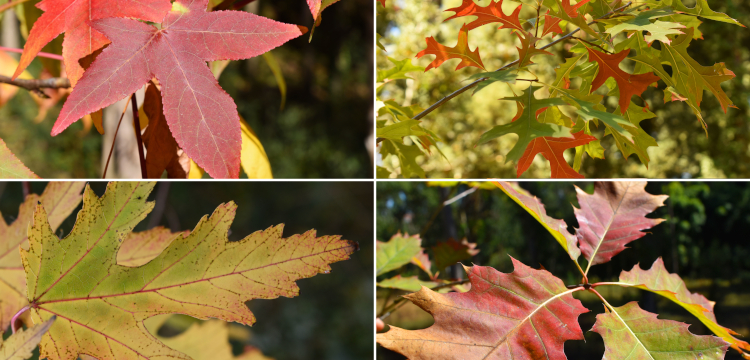Autumn Colors at Quinta de S. Francisco
While spring bright colors are due to flowers, which with their dazzling colors attract the pollinators, in autumn, the colorful scenery comes from the leaves. These colored leaves usually shown in deciduous trees or shrubs, which shed their leaves in response to the approach of the winter season. They do so mainly to avoid the loss of water (which may not be accessible, because it is solid, in the form ice or snow) or to prevent leaf tissue from being destroyed by frost. Some plants such as the ones from Pinaceae family and other resinous plants have solved these problems with small leaves (needle type), that reduce the leaf area and with waterproof cuticles, which minimize the water loss. This strategy allows them to maintain leaves all year round.

Caption:
American sweetgum (Liquidambar styraciflua, left) and the tulip tree (Liriodendron tulipifera, right) showing their autumn colors.
American sweetgum (Liquidambar styraciflua, left) and the tulip tree (Liriodendron tulipifera, right) showing their autumn colors.
The process of leaf shedding is triggered by the decreasing photoperiod (less daylight hours) of this season, which becomes evident in middle or high latitudes. When the number of daylight hours falls below a minimum limit (which differs for each species), it starts the entire process of senescence and leaf shedding. During this process, chlorophyll, the most abundant pigment in the leaves with its green color, is degraded naturally and is not replaced, while many other protein components of the leaves are absorbed by the plant and stored in the trunk or roots until the next spring. However, as the plant cuts off the bond with the leaves, a number of other compounds, which were previously masked by the green color, are left behind. These compounds are usually xanthophylls, such as zeaxanthin, which gives the characteristic yellow color to corn (Zea mays) or carotenes, such as β-carotene, which gives the characteristic orange color present in carrots (Daucus carota) or anthocyanins , with more vibrant colors, from purple to red, present in large quantities in the american sweetgum (Liquidambar styraciflua).

Caption:
Corn (Zea mays) and carrots (Daucus carota) are rich in zeaxanthin and β-carotene, respectively (left). Although eucalypts are evergreen, they lose their leaves regularly throughout the year, with them acquiring similar colors to the deciduous trees (right).
Corn (Zea mays) and carrots (Daucus carota) are rich in zeaxanthin and β-carotene, respectively (left). Although eucalypts are evergreen, they lose their leaves regularly throughout the year, with them acquiring similar colors to the deciduous trees (right).

Caption:
Leaves of the american sweetgum (Liquidambar styraciflua) and silver maple (Acer saccharinum) on the left and scarlet oak (Quercus coccinea) and northern red oak (Quercus rubra) on the right. It should be noted that the purple colors that liquidambar leaves can have are due to the presence of large quantities of anthocyanins.
Leaves of the american sweetgum (Liquidambar styraciflua) and silver maple (Acer saccharinum) on the left and scarlet oak (Quercus coccinea) and northern red oak (Quercus rubra) on the right. It should be noted that the purple colors that liquidambar leaves can have are due to the presence of large quantities of anthocyanins.
Come visit us and discover more about the fantastic floristic diversity of Quinta de S. Francisco and its autumn colors.
More articles













